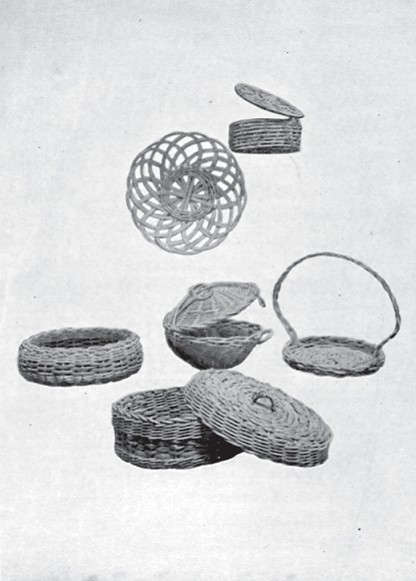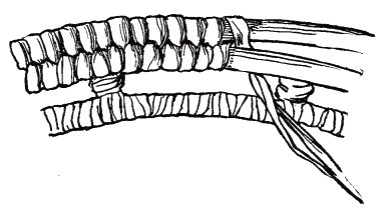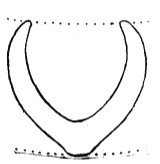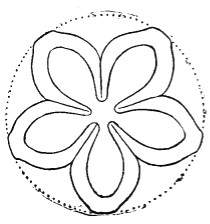| Web
and Book design,
Copyright, Kellscraft Studio 1999-2010 (Return to Web Text-ures) |
 (HOME)
|
| CHAPTER VIII
CANDY BASKETS CHILDREN will delight in weaving baskets of this kind, and with the fine grades of rattan, with rush in its beautiful natural shades, and raffia which takes color so well, the possibilities for dainty little favors and effective larger baskets are endless.
Materials: 10 20-inch spokes of No. 4 rattan, 1 11-inch spoke of No. 4 rattan, 5 weavers of No. 2 rattan, 2 weavers of No. 2 colored rattan.
Two weavers of colored rattan, dyed according to one of the descriptions in Chapter XII, form the band on this basket, which is woven, in a simple Indian shape, of rattan in the natural color. Two groups of spokes, one of five and the other of five and a half, are crossed in the centre and bound around three times with No. 2 rattan which is woven in under-and-over weaving into a flat bottom, about six and a quarter inches in diameter. The spokes are then wet thoroughly and turned up, rounding them gradually. After about a quarter of an inch has been woven up the sides, two colored weavers are woven into four rows of double weaving, which are drawn in slightly toward the top; three rows of under-and-over weaving in No. 2 rattan are also slightly drawn in, and then the top is bound off and finished with this border. Each spoke is brought back of the next one on the right, in front of the next, back of the next and then out, taking special care to leave the first spokes loose so that the last ones can be easily woven in. They are then cut slanting just long enough to allow each to lie across the spoke in front of it.
Materials: BASKET.-8 18-inch spokes of No. 4 rattan, 10-inch spoke of No. 4 rattan, 16 9-inch spokes of No. 4 rattan, 5 weavers of No. 2 rattan, Flat brown rush. COVER AND HANDLE-8 16-inch spokes of No. 4 rattan, 1 9-inch spoke of No. 4 rattan, 16 8-inch spokes of No. 4 rattan, 1 12-inch spoke of No. 4 rattan, 5 weavers of No. 2 rattan, Flat brown rush, A knitting needle.
The soft shades of brown in the rush, combined with rattan in its natural color, harmonize beautifully in this basket which, after it has been used for candy, may be lined and transformed into a work basket that will last for years. The eighteen-inch spokes, in groups of four and four and a half, are crossed in the centre and a length of brown rush, previously wet until pliable, is bound about them in this way: The end is started back of the upper vertical spokes and lying along the horizontal ones, with the tip toward the right. It is then brought in front of the upper vertical spokes, down back of the horizontal ones to the right, in front of the lower vertical ones, then diagonally up back of the centre to the space between the upper vertical spokes and the horizontal ones on the right; next in front of the horizontal ones on the right, diagonally up across the back of the centre to the space to the left of the upper vertical spokes. Then down in front of the horizontal spokes on the left, and back to the space on the right of the upper vertical spokes, where the spokes are separated and the weaving begins. A centre three and three-quarters inches in diameter is woven of rush, then the extra sixteen spokes are inserted, one to the right of every spoke but one, on the wrong side of the work, and two rows of triple twist in No. 2 rattan holds them firmly in place and covers the joining. Four rows of rush are woven, and the spokes are wet until perfectly pliable, when they are turned sharply up and the weaving of the sides is begun with half an inch of triple twist. Five rows of rush in under-and-over weaving follow and then five-eighths of an inch of triple twist makes a firm band at the top. The border is a simple one, finished inside so as to allow the cover to slip on and off easily. Each spoke is brought in front of the next one to the left and down inside. Cover. — In making the cover the spokes are crossed and bound as they were in the basket. A centre, four and three-quarters inches in diameter, is woven with the rush; the sixteen extra spokes are then inserted, as in the basket, and bound firmly with two rows of triple twist. Five rows of rush are woven in under-and-over weaving and then the spokes are thoroughly wet and bent up sharply. Five-eighths of an inch of triple twist in No. 2 weavers makes an overlapping edge, which should be perfectly straight and true. In ending the triple twist the method described on page 75 is recommended. A border is made by bringing each spoke back of the one on the left and then out. A small handle by which to lift the cover is formed of a piece of No. 4 rattan. It is started by weaving it under and over two or three spokes near the centre, bringing the long end up on the outside, between two of the centre spokes just beyond the binding, and down on the opposite side of the centre, beyond the place where it is bound with the rush. It is brought across again and then woven under and over several spokes to fasten it. This makes two loops of rattan both about half an inch high and lying close together. An end of very pliable rush is now started at one end of this foundation handle, on the right of it, and brought over and around the left loop, then out between the loops, around the right loop, out again between the loops and around the left. This is repeated until the rattan is entirely covered with rush (the stitches pressed close together), making a handle which is quite in keeping with the rest of the basket.
Materials: 24 30-inch pieces of No. 2 rattan, 2 weavers of No. 2 rattan.
This basket is a popular one, not at all difficult to make, and with a pretty little lace paper doily by way of a lining it holds candy very well. The twenty-four pieces of rattan, previously soaked until pliable, are separated into groups of six each which are arranged in the Indian way described on page 67. A weaver of No. 2 rattan is doubled around the upper end of the vertical group, with its ends toward the right. It is woven in two rows of pairing, starting at about an inch from the centre. A third row of pairing is then woven, dividing each group into groups of three each. The ends of the weavers are finished off by cutting them, at about an inch beyond the end of the third row of pairing, and pushing each through a loop in the weaving on the wrong side, to hold it fast. Each group of three spokes is then brought over the next group on the right, under the following one, over the next, under the next and outside down by the weaving, making a loop about two and a half inches high and some long ends of each group. The first loops especially, should be left loose, so that the last two or three groups can be easily finished off. When this mat has been made even on all sides, by pulling the loops out or drawing them in, it is molded up into a bowl shape with the hands. It is then placed, top downward, on the worker's knee and a weaver of No. 2 rattan doubled in the centre is started, around the end of a group, at the point on the circumference of the basket where the first pairing ended. Three rows of pairing are woven to make the beginning of a base, taking care not to draw in the groups too much, but to keep the sides of the base straight. The end of each group is then brought over the next group on the left, and pressed down inside the base, where it is cut off afterward.
Materials: BASKET.-16 20-inch pieces of No. 2 rattan, 3 weavers of No. 2 rattan. HANDLE. - 6 22-inch pieces of No. 2 rattan, A knitting needle. This basket makes a charming little favor for luncheon or dinner. A small paper doily with a lace edge may be laid inside and the candy arranged upon it. The centre is started with sixteen twenty-inch pieces of No. 2 rattan, separated into four groups of four each, and crossed in the Indian manner already described on page 67. The weaver is started in front of the group to the left of the upper vertical group. It then goes back of the upper vertical group, in front of the next group, back of the next and so on, until one row has been made. In the second, third and fourth rows the weaver is brought under and over the same groups as in the first row, but in the next row it is first brought back of the upper vertical group and the group on the right of it, then in front of the next group, back of the next and so on. Four rows are woven in this way and then the groups of four are divided into twos and the weaver is brought over the first group of two on the right of the upper vertical group, under the second, and so on. The next row is woven under and over the same groups, but at the end of that row the weaver is brought behind two groups, and the weave changes again. It is now in groups of two weavers crossing two spokes, and continues in this way till the basket is finished. New weavers are joined to the old by whittling the end of each to a flat point two or three inches long. These points are held close together and woven along like a whole weaver. When the bottom is about four and three-quarters inches in diameter, a braided handle is made and inserted according to the description in Chapter VI, using six pieces of No. 2 weaver twenty-two inches long. When the bottom is five and three-eighths inches in diameter the groups of spokes are wet and turned up to form the sides, which are not over half an inch high. The border is the same as the one described on page 68, only it is drawn in very tightly so as to make the plait lie almost flat. This basket may be colored with a vegetable dye, according to the directions in Chapter XII, or it may be left the natural color of the rattan.
Materials: BASKET-6 22-inch spokes of No. 4 rattan, 1 12-inch spoke of No. 4 rattan, 4 weavers of No. 2 rattan. COVER, HINGE, ETC.-6 18-inch spokes of No. 4 rattan, 1 10-inch spoke of No. 4 rattan, 3 1/2 weavers of No. 2 rattan, A knitting needle.
What makes this basket unusual and attractive is the hinge, top-handle and fastening, which are all formed of one weaver in a series of twists. The basket and cover are simply made. Two groups of spokes, twenty-two inches long, one of three, and the other of three and a half, are crossed in the centre, bound three times around, and woven into a bottom two and a half inches in diameter. The spokes are then wet and bent upward with a decided flare which, when four weavers have been used, should make the diameter of the top about five inches. It is then bound off and finished with this border. Each spoke in turn is brought back of the next spoke on the right, in front of the next, back of the next, in front of the next, and pressed down inside the basket. This being such a deep border, the first part of it should be left loose and open, that the last spokes may be fitted into place without any trouble. It should be remembered in weaving in these last spokes that each time a spoke crosses another it goes one row farther down in the border, until at last it lies on the weaving. Cover. — The cover is begun like the bottom of the basket, except that it is flared up and out from the very centre. Two weavers are used, and toward the end of the second the spokes are flared until they lie in a horizontal position. When the diameter is five and a quarter inches the edge is bound off and finished with the Rope Border described on page 39. Hinge, Top Handle and Fastening. — A weaver of No. 2 rattan is cut into fourths, these are then separated into pairs, which are doubled at the centre and knotted according to the directions on page 61. This knot is drawn up until it is about two inches across. It is then placed in the centre of the cover with the ends extending over the front and back of the basket. The pairs of ends which are toward the back of the basket are crossed, the left being the upper one, and they are pressed down through the cover, one on either side of a spoke, and between the last row of weaving and the border. Each pair is now brought through a loop in the centre of the border of the basket, and after crossing again (the right over the left), they are fastened off, one on either side of a spoke at about half an inch from the bottom. The hinge and top handle are then completed. To make the cover fastening, the pairs of ends toward the front are crossed (the right over the left), and brought down between the first and second rows of weaving from the edge, one on either side of a spoke. They are crossed again at about an inch and a half below the edge of the cover (the left over the right) to make the beginning of a loop. The end on the right is now brought up, back of the right side of the loop and through it, while the end on the left is brought up and over the left side of the loop. They cross in the middle of the loop near the edge of the cover (the right being uppermost) and are finished off, one on each side of the spoke, and between the border and the last row of weaving on the cover. A larger ring on the basket forms the other part of the fastening, and is made as follows: Two pieces of No. 2 weaver, sixteen inches long, are laid together and bent into a loop at about an inch from the middle (the ends turning down) by crossing the right pair of ends over the left. Those on the left are then brought under the left side of the ring and out, while the other pair are brought over the right side of the ring and in, completing a ring which should be just large enough for the loop on the cover to pass through. The ends are inserted, one pair on either side of a spoke, in the front of the basket, where they cross and are woven to right and left between the sixth and seventh rows of weaving below the border, or just where the loop on the cover will pass through the ring and form a fastening.

CANDY BASKETS In the foreground is the brown rush and rattan covered basket; directly above It a smaller basket with elaborate hinge, top handle and fastenings is placed. At the left is an attractive Indian shape ornamented with a pale-green hand. The shallow basket on the right makes a charming favor for a dinner or cotillon
Materials: BASKET-1 length of No. 4 rattan, A bunch of raffia, A bunch of orange raffia, A bunch of black raffia, A tapestry needle, No. 19. COVER AND HINGE- 1/2 a length of No. 4 rattan, A bunch of raffia, A bunch of orange raffia, A bunch of black raffia. Time and patience might be added to the above list, for it will take a good stock of both to make this basket. The result, however, should be pretty and original enough to compensate for it all. A length of No. 4 rattan is soaked until pliable. The end is then coiled into the smallest possible ring and a needleful of raffia is started, with the end toward the right, in the centre of the ring, and sewed over and over from left to right with a tapestry needle. The next coil is brought around at a little distance (about the width of No. 4 rattan) from the first one and, when a quarter of the second row of coiling has been made, the raffia is brought down through the centre, up and round once again, thus holding the first coil to the second by a joining, which is made more secure by binding it twice around with the raffia in the opposite direction to the way it is wound around the rattan. When the coil has been brought half way around the second time another of these joinings is made. There is another one when three-quarters of the row has been coiled, and still another at the beginning of the third row of coiling. The next joining should be just to the right of the first one, and from that on, each row is joined to the next at the right of the joinings on the previous row. Thus these joinings form a pattern, like the spokes in the all rattan baskets, and answering the same purpose. As the coils grow larger the number of joinings must of course be increased, for the same reason that extra spokes are inserted in weaving, to keep the work firm. This is done by putting one between each of the other joinings. New needlefuls of raffia are always started at a joining. The needle brings the end of the old strand from left to right, through the upper part of the joining, leaving the end lying along the under side of the rattan. The new needleful is then brought from right to left through two twists of the raffia and drawn up so as to leave a short end lying along the rattan. The winding then begins again and soon covers both ends. At the end of the tenth coil the rattan is brought up directly above that coil, leaving the same distance between the new coil and the one below it as there was between the other coils. Each coil now follows just above the previous one — making a straight-sided basket, eight coils high. The ninth coil is brought just inside the eighth, in order to make a little rim for' the cover to rest upon. In making the ninth coil, when about two and a quarter inches from the point on the circumference of the basket where the coil was brought up to form the sides, the rattan should be cut just long enough to complete the row and whittled to a long, flat point, which is sewed close to the previous row of coiling.
 FIG. 20 Cover.-The cover is wound and coiled in the same way as the bottom of the basket as far as the end of the ninth row of coiling, when a border is made by bringing the tenth row close to the ninth with the stitch shown in Fig. 20. The extreme end of the rattan is whittled to a long point and sewed in with the previous row.
 FIG. 21 The designs on the basket and cover are worked before they are fastened together. Beginning with the basket — the circumference is divided into fifths, and a line of black thread is run from top to bottom of the basket, at each of the five points, to form a centre line for the petal-shaped design shown in Fig. 21. The design may also be outlined in black basting thread or done by eye, in stitches which run under and over the coils like weaving, except that the raffia is brought through the previous row each time (instead of simply crossing it) between the coils. The design on the model was first worked in orange raffia, and then outlined inside with two rows of black. The design on the cover is like a five-petalled flower (see Fig. 22), and after it has been worked, the cover is placed on the basket so that the end of each petal will come in the space between two of the petals on the basket.
 FIG. 22 Hinge. — The place where the hinge is to be made on the basket having been decided upon, a ring of raffia is formed by sewing a strand twice around the last two rows of coiling at the left of a joining, and covering it with button-hole stitch in raffia. Another ring is made on the right of the joining in the same way. At a point on the cover, just above the ring on the right, a needleful of raffia is attached, run through the rings and then around the last row of coiling on the border. It is drawn up until it forms a loop just loose enough to allow the cover to open easily, when it is covered with button-hole stitch. |